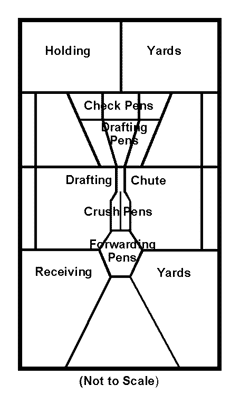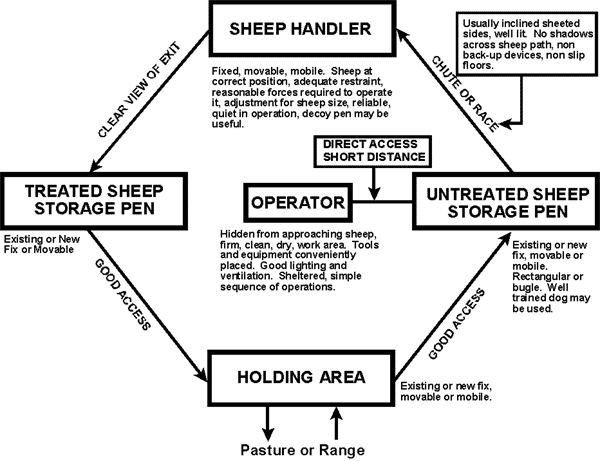
Introduction:
Well designed equipment is essential to good management. Labor costs have increased dramatically in recent years and this means that the producer must run more animals. This is made easier if the producer has good handling pens and equipment that allows work to be carried out quickly and efficiently. There is no ideal pen design because requirements and sites vary between individual ranches and farms. However, the principles are common to all situations and can be adapted to suit a particular operation. If facilities are to give many years of useful service, considerable planning and forethought are required.Animal Movement:
Animal movement can be enhanced if the following information is kept in mind:
Handling Facilities:
General Considerations:
Facility layout should be as simple as possible, compatible with the work to be done. It should be possible to carry out the various tasks with minimum movement by the handler. A continuous flow of animals from the collection area, up the chute (race), or into the working area should be the goal. It should be possible to recycle the animals without disturbing other animals in the working area or holding pens.Gates and catches should be easily operable and all surfaces should be smooth. The ground surface should be non-slip. Concrete is recommended for working areas and for draining pens used to spray and dip the animals.
Materials for the facility can be wood, metal, steel mesh, and concrete blocks, with the costs increasing in that order. Wood is the simplest to use, but all wooden posts should be pressure treated with a preservative before installation. Pressure treated posts tend to last longer. Metal is a good substitution for wood because it is stronger and requires less maintenance. Concrete is a permanent alternative, but this characteristic makes it difficult to modify, enlarge, or add to at a later time. Recently, some well designed, semi-portable and completely portable metal and aluminium handling systems have become available. These systems have proved efficient in practice. However, they can be costly for larger layouts. A good compromise is to use this type of equipment for the chute (race) and cutting gates, and to construct the holding pens and perimeter fencing from wood or other material.
It is recommended that the sides of the chutes be sheeted, but that the gates at the end of a chute should allow animals to see through. This causes the animals to move towards the light and other animals at the end of the chute.
Operations such as semen examinations, pregnancy testing, vaccination, drenching, identification, selection, culling unsound animals, foot inspection, tagging, facing, and trimming can be performed while animals go through a handling facility. This helps to stream-line husbandry practices and helps reduce labor inputs and costs. The more tasks that can be performed at one time, the less time and effort will be required in gathering and herding animals to and from the corrals. If the handling unit can be taken to the animals, rather than the animals taken to the facility, time consuming travel may be reduced. Portable or easily dismantled units, along with the establishment of simple, permanent corrals (yards) at key points on the ranch or farm, will aid such movement.
A number of factors should be considered before purchasing handling devices:
Site Selection: The site for an animal working facility should be convenient for access to both the animals and the producer. It should be near water and electricity. It should also be free-draining and sheltered if possible.
Working Facilities: Generally, large working yards embody the following components: (For small producers some of these areas can be omitted.)
Examples of Successful Handling Facility Designs:

Sheep Handler Flow Chart:

Space Requirements for Engineering Facilities:
Feeder Space
Waterer Space
Shelter Space
Warm Housing
* Note: All numbers and data provided are based on averages for all breeds of sheep and goats. Variations will occur depending upon the body size and the breed of the animal being raised.